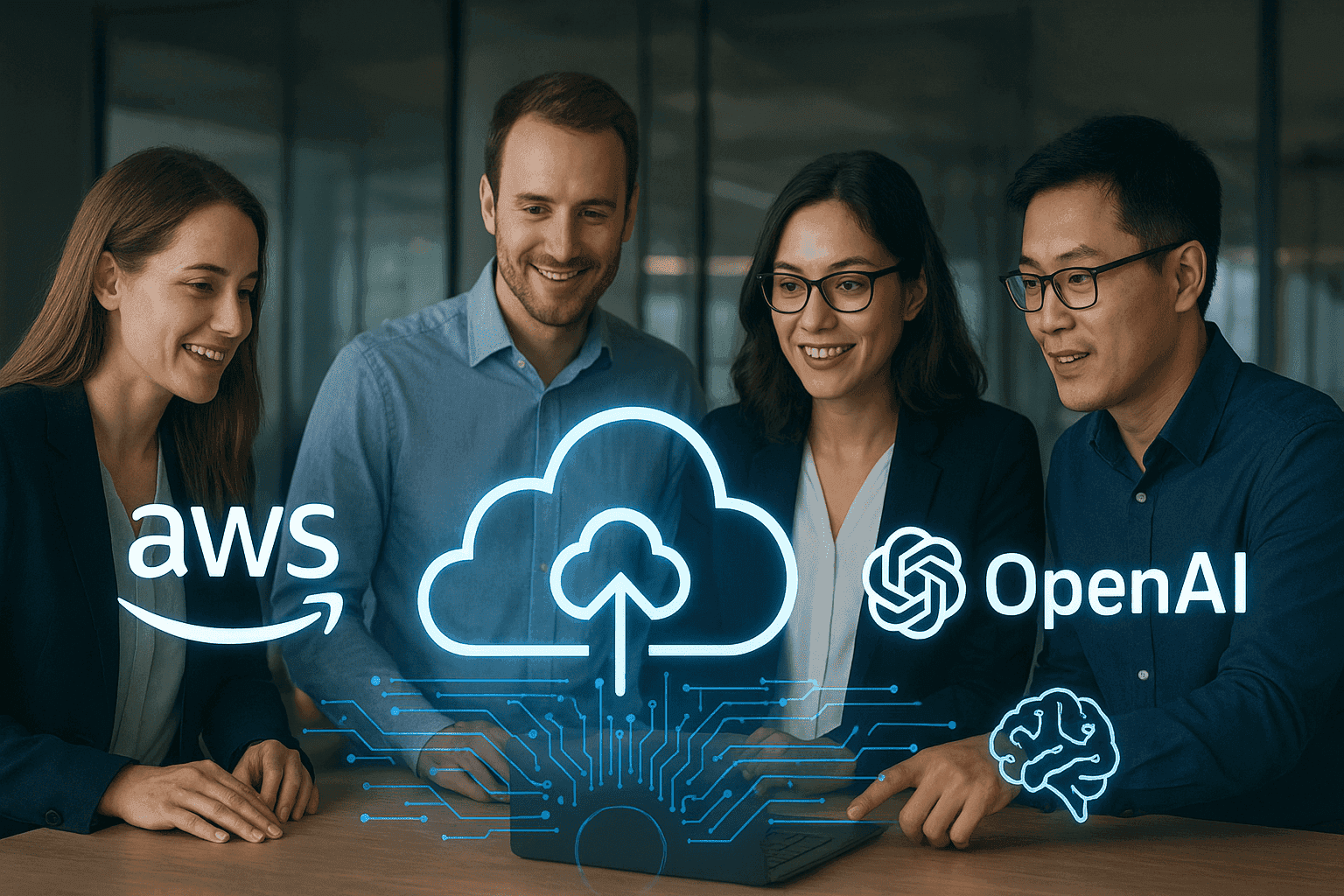OpenAI and AWS have sealed a landmark $38 billion agreement under which OpenAI will use AWS’s global infrastructure—including racks of Nvidia GPUs—to train and run its most advanced AI systems. This deal matters not just because of the sheer size, but because it signals a shift in cloud power dynamics: AWS is reclaiming momentum in the AI infrastructure race, while OpenAI is diversifying its compute base at a pivotal time. The move impacts cloud providers, enterprise customers, developers, and anyone tracking how artificial intelligence will scale in the next decade.
Background & Context
The demand for compute to train and serve frontier AI models has exploded. OpenAI, known for its flagship model ChatGPT, has been aggressively scaling infrastructure to stay competitive. A recent restructuring gave OpenAI more freedom to partner broadly rather than relying solely on one cloud provider.
Meanwhile, AWS has faced pressure from rivals such as Microsoft Corporation and Google LLC, which have established strong AI-cloud propositions. By striking this partnership, AWS aims to reaffirm its position amid the infrastructure arms race around generative AI.
OpenAI has signed a seven-year agreement with AWS valued at approximately US$38 billion.
Key Facts / What Happened
- OpenAI has signed a multi-year strategic partnership with AWS valued at approximately $38 billion over seven years.
- The agreement gives OpenAI immediate access to AWS’s compute infrastructure — including “hundreds of thousands” of NVIDIA GPUs and the potential to scale into tens of millions of CPUs over time.
- The infrastructure deployment is planned to be fully online by end of 2026, with potential expansion into 2027 and beyond.
- AWS CEO Matt Garman described the deal as proof that AWS is "uniquely positioned" to support vast, frontier AI workloads.
- For OpenAI CEO Sam Altman, the deal represents a strategic diversification and an escalation of its computing ambitions.
What’s Driving the Deal
Compute Demands
The training and operation of large-scale AI models (LLMs, agentic systems) require massive compute, memory, extremely fast interconnects and huge infrastructural scale. OpenAI’s deal with AWS is clearly pitched as a capacity- and performance-play.
Diversification Strategy
OpenAI previously had a structural arrangement with Microsoft. Under recent restructuring, OpenAI has more freedom to partner with other providers. This is one of the first major moves of that strategy.
AWS Reasserting Its AI Infrastructure Position
AWS had been seen as slightly trailing rivals in the newer “AI cloud” arms race (for example, Microsoft + Google). This deal gives AWS a big commitment from one of the lead AI model creators — enhancing its credibility.
Technical Highlights
- The clusters will utilise AWS’s EC2 UltraServers equipped with NVIDIA’s GB200 / GB300 series AI accelerators.
- The architecture is designed for both model training (which is extremely compute- and memory-intensive) and inference/serving at scale (which demands high throughput, low latency).
- By gaining access to tens of millions of CPUs in addition to GPUs, the deal acknowledges that “agentic” AI workflows (where AI undertakes tasks autonomously) require hybrid compute resources.
- Because the deal spans multiple years and includes large infrastructure commitments, it represents a long-term strategic bet on AI scale, not just a short-term pilot.
Voices & Perspectives
“This is a hugely significant deal and clearly a strong endorsement of AWS compute capabilities to deliver the scale needed to support OpenAI,” noted analyst Paolo Pescatore of PP Foresight.
From OpenAI’s side, Altman said: “Scaling frontier AI requires massive, reliable compute… Our partnership with AWS strengthens the broad compute ecosystem that will power this next era.”
On the enterprise front, observers point out that for large organisations building AI-driven services, the ability to tap into elastic, GPU-rich infrastructure is now non-negotiable.
Broader Implications
For OpenAI
- The deal helps mitigate the risk of compute bottlenecks as OpenAI scales its systems and users grow.
- By diversifying providers, OpenAI reduces “single-vendor dependency” — relevant for risk, pricing leverage, and flexibility.
- However, it also obliges significant spending, and questions remain about how all of this cost will be monetised. Some analysts note a potential AI infrastructure “bubble”.
For AWS & Cloud Market
- AWS gains a marquee, high-visibility customer commitment that strengthens its positioning in the AI infrastructure market.
- For enterprises and other AI model creators, this signals that AWS is likely to remain a major contender for frontier AI workloads — potentially influencing pricing, regional data centre expansion, partnership strategies.
- Rival cloud providers (Microsoft, Google Cloud, etc.) will feel the competitive pressure more acutely.
For the Industry
- The scale of compute now being locked into multi-billion-dollar deals suggests the infrastructure arms race for AI is intensifying.
- AI model capability is increasingly limited not by algorithms alone but by access to massive, well-engineered infrastructure.
- Smaller players and emerging markets may face increasing hurdles if such scale becomes a key competitive advantage.
Risks & Considerations
- While the deal is huge, the return on this investment remains to be seen — training and serving next-gen AI models is expensive and the commercial payoff is not guaranteed.
- Operational risks: building, managing, cooling, powering huge GPU clusters is complex and energy intensive. Infrastructure downtime or poor yield could impact ROI.
- Vendor lock-in concerns: even though OpenAI is diversifying, being tied to large cloud providers for long contracts still carries strategic risks.
- Market/valuation risk: Some analysts warn of an AI-infrastructure bubble if many players make massive bets but monetisation lags.
What’s Next / Future Outlook
In the months ahead we’ll be watching:
- How quickly the capacity gets deployed and becomes operational by end of 2026.
- Which other cloud providers respond with counter-moves or partnerships of their own (e.g., Google, Microsoft).
- How this infrastructure will translate into new AI capabilities or products from OpenAI (and competitors).
- Enterprise uptake: will business customers benefit from more flexible, powerful AI-cloud offerings?
- Regulatory or financial implications: such mega-deals will draw attention from antitrust, energy-usage, and sustainability angles.
